
Annenkov's Cossack and Native Cavalry
Annenkov was a Siberian Cossack himself, and he recruited largely from Cossacks.
The units below are also shown at kolchakiya.ru although it can be very hard to decipher which are which.
1stOrenburg Cossack Regiment
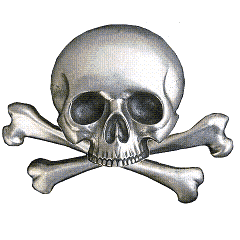 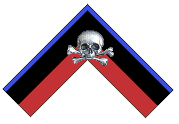 |
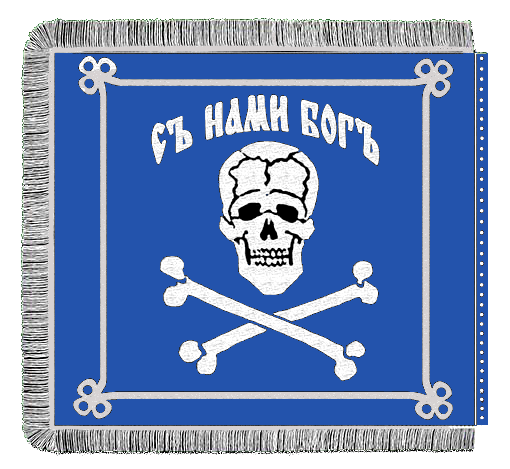 |
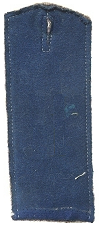 |
| Cockade and chevron reconstruction | Flag speculation | Shoulderboard reconstruction |
The longest serving unit in Annenkov's forces was his Orenburg Cossack Regiment. He started to recruit this unit as soon as he moved to the Verkhneuralsk area in about August 1918, and they stayed with him into China.
They basically dressed in standard Orenburg Cossack uniforms, with "light blue" (actually more a mid-blue) trouser stripes, cap band and shoulder straps. The differences from normal Orenburg Cossack uniforms were:
- the cockade was a death's head, either directly or in a circular medallion.
- the shoulderboards had no cipher.
- a red/black shoulder chevron with an upper blue edge was worn.
At times horses were in short supply, and some Cossacks may have been obliged to serve on foot.
1st Siberian Cossack Regiment
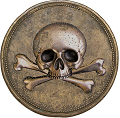 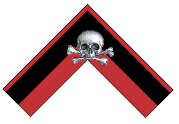 |
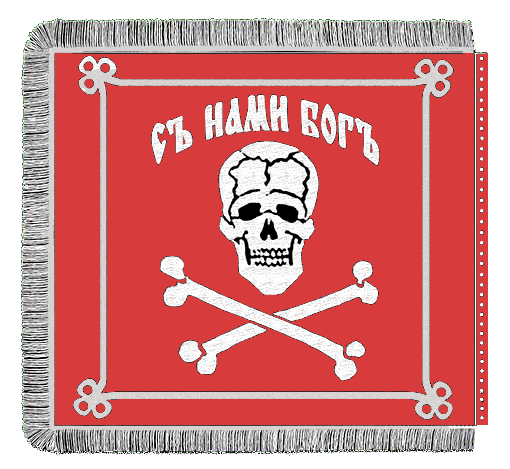 |
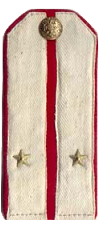 |
| Cockade and chevron reconstruction | Flag speculation | Junior officer shoulderboard |
This was Annenkov's first mounted unit, made up of local Siberian Cossacks. In mid-1919 it turned into the Partisan Escort Regiment.
Uniform was that of standard Siberian Cossack Cavalry, with red trouser stripes, cap band and shoulder straps, differing in that:
- the cockade was a death's head, either directly or in a circular medallion.
- the shoulderboards had no cipher at the start, then added an "A" when it became the Escort Regiment.
- a shoulder chevron with an upper red edge was worn.
The regiment disappears from the list of units, but the "Life Ataman Regiment" appears at the same time. The obvious conclusion is that the Life Ataman is the old Siberian regiment. It makes sense that Annenkov, as a Siberian Cossack, would make a Siberian Regiment his Guard unit.
Life Ataman Regiment
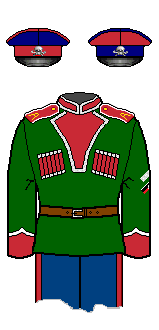 |
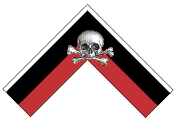 |
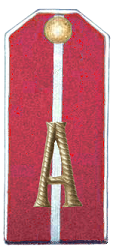 |
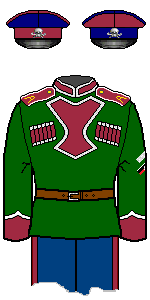 |
|---|---|---|---|
| Full uniform in Siberian Host colours | Chevron with white piping | Shoulderboard reconstruction | Alternative version in Semirechensk colours |
There is a lot of doubt over exactly what colours this unit wore, because the black and white photos are no help. The versions above assume that they were dressed based on full dress uniform as it stood in 1914. We think the left hand version is most likely as Annenkov was a Siberian Cossack, and the unit was originally formed from Siberians. The differences from the 1914 uniform were Annenkov's death's head cockade, the arm chevron piped white, and a gold "A" on the shoulderboards. The shoulderboards are shown piped white, which had been Imperial practice for guard Cossacks.
The right hand variant show the same basic pattern but with raspberry differences, as Semirechensk Cossacks may have enlisted in this regiment. It may well have been that both colours were seen, perhaps in separate sotnias.
The standard Cossack dress cap was blue topped with band and piping in red (raspberry). Its possible the Annenkov Life Ataman Regiment caps were in red (raspberry) with a blue band and piping, as that was the colours for the Siberian (Semirechensk) Cossacks of the Tsar's Composite Cossack Guard Regiment. However supplies of such items would be slim, apart from the men who had actually served in the Guard.
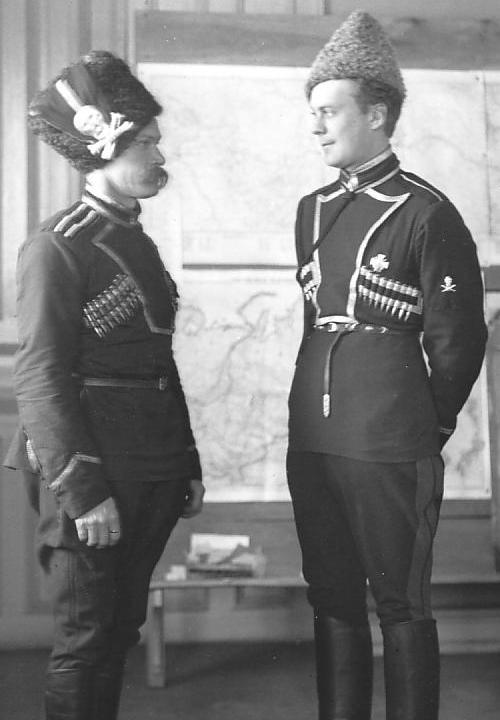
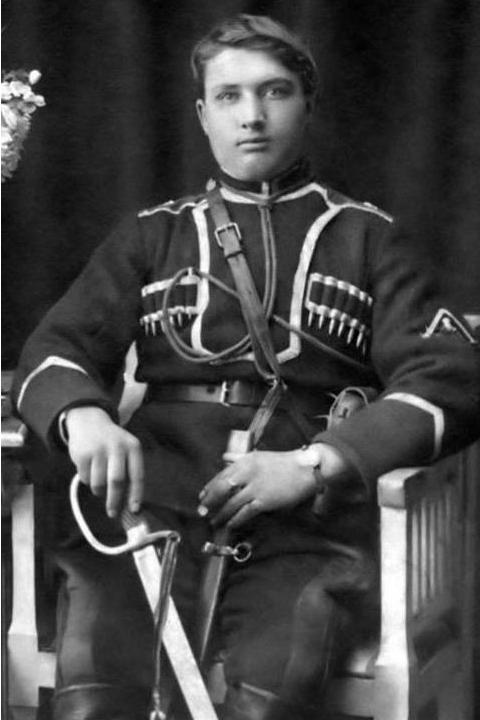 We don't know what percentage of troopers actually wore this fancy uniform but we have pictures of some men in it, and it looks remarkably fresh and new.
We don't know what percentage of troopers actually wore this fancy uniform but we have pictures of some men in it, and it looks remarkably fresh and new.
Perhaps stocks of the pre-war dress uniform were found. (The Soviets dressed some units this way in the RCW.)
The man on the far left has a papakha with large bag coming down the side. This was also part of the Imperial Cossack dress uniform. The large skull and crossbones is a Partisan Division addition.
However, it is possible that the men we see dressed so prettily were just the personal escort sotnia to Annenkov, rather than representative of the unit as a whole.
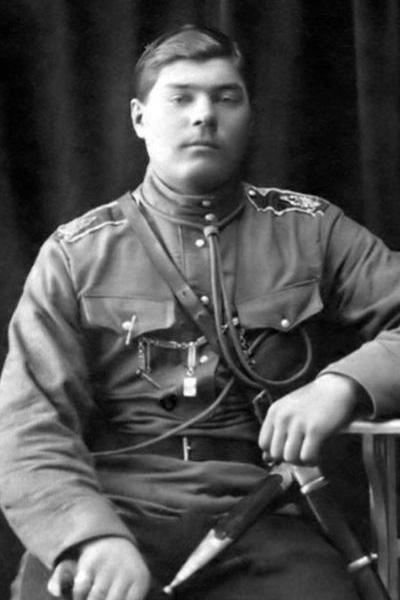 I wonder if the bulk of the unit weren't dressed as more or less normal Siberian and/or Semirechensk Cossacks, such as we see on the man to the left here.
I wonder if the bulk of the unit weren't dressed as more or less normal Siberian and/or Semirechensk Cossacks, such as we see on the man to the left here.
He is wearing standard Cossack uniform part from the shoulderboards, which were piped white with the addition of a gold "A" (from when the unit adopted the "Ataman" title in mid-1919).
(Note the Cossack dagger at his waist, to go with his sabre.)
The Life Ataman Regiment was a fighting unit, not just a guard unit, and for all its pretty uniforms it was one of the better units of the White forces in Siberia.
2nd Ust-Kamenogorsk Cossack Regiment
By May 1919 this regiment appears in the order of battle, but it was probably recruited from when Annenkov first arrived in the area, so starting in winter 1919.
In July it had 20 officers and 485 Cossacks in three sotnias and an MG team. A fourth sotnia was made up of Kirghiz volunteers. It seems to have been in the north, around Pavlodar, at the end of 1919 and fallen apart under pressure from the Red Army advance in that region. It did not make it to China.
As the town of Ust-Kamenogorsk is in Siberian Cossack territory, Annenkov was headquartered in Siberian Host lands (Semipalatinsk), and the unit was the second of something, the obvious conclusion is that it was composed of Siberian Cossacks. It follows that it wore a uniform based on Siberian Cossacks. At about this time the 1st Siberian Regiment added an "A" to their shoulderboards, which may not have been coincidence. This would have left the 2nd Regiment able to have plain red facings and still be different.
This unit may have struggled to obtain sufficient mounts for all the men.
There was a brief attempt to recruit another regiment from the Ust-Kamenogorsk region, but it never seems to have had very many men, and perhaps was never mounted at any time.
1st Kirghiz Regiment
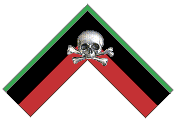 A Kirghiz unit was formed in early 1919, and lasted until the end of the period in Semirechye.
A Kirghiz unit was formed in early 1919, and lasted until the end of the period in Semirechye.
It is sometimes listed as Kirghiz-Kalmyk, but any "Kalmyks" will actually have been shamanic Altai or similar (actual Kalmyks did not live in the area, and anyway were much more likely to be brigaded with their co-religionist Mongols).
Its unit colour was green, which was a fairly standard colour for Moslem peoples, worn on shoulderboards and piped on the arm chevron. At Kolchakiya.ru the shoulderboards are shown piped white, but that seems unlikely as it was not Tsarist practice, and we prefer plain green shoulderboards. No cipher is given.
The unit was probably commanded in action by Russians.
A horse tail banner would be consistent with usual Turkic cavalry practice.
Other Kirghiz
There was for a time some partisan Kirghiz regiments in Annenkov's order of battle, which appear to have fought separately from the rest of the division most of the time. An order of battle for July 1919 has Annenkov commanding three Kirghiz regiments, each of three or four sotnia. This may be the same units sometimes listed with the Semirechensk forces.
They presumably fought in native clothing.
Manchurian Horse-Jäger Regiment
This unit first appears in mid-1919, when at the same time the infantry Jäger unit disappears. The obvious conclusion is that it is the same unit, now with a mounted component. By 1920 it was brigaded with the Kirghiz in a mounted brigade, so presumably was largely or entirely horsed by that point.
The "Manchurian" would indicate that it was composed of Mongol tribesmen, who were common in the area. It would likely have been commanded in battle by Russian officers.
The unit's colour was yellow, which was a standard colour for Buddhist units (Don Kalmyks, for example). It would be normal for the standard of such a unit to be some variety of horse or yak tail arrangement.
Semirechensk Cossacks
Orders of battle do not show any Semirechensk Cossack unit in the line-up of the Partisan Division. They had their own Host brigade in any case. Individual Semirechensk Cossacks who joined the Partisan Division were likely enrolled in the Ataman Regiment, although officers may have been used to command the Native units.
At kolchakiya.ru a Field Gendarme Sotnia is shown in what is basically normal Semirechensk outfits. (Other gendarmes are shown with dark blue facings, but presumably these were rear area men.)